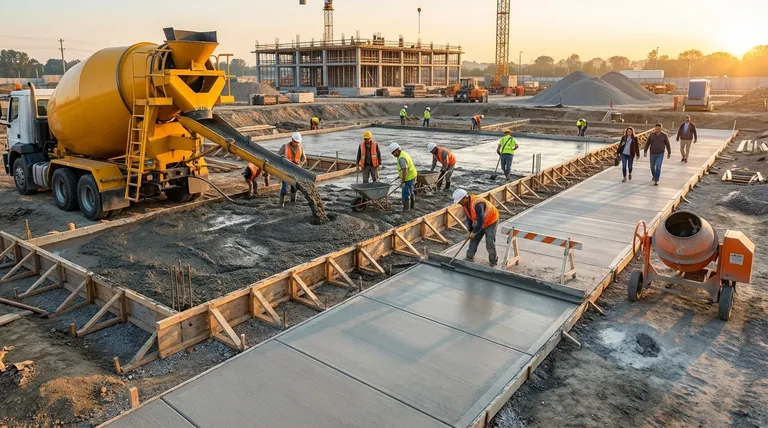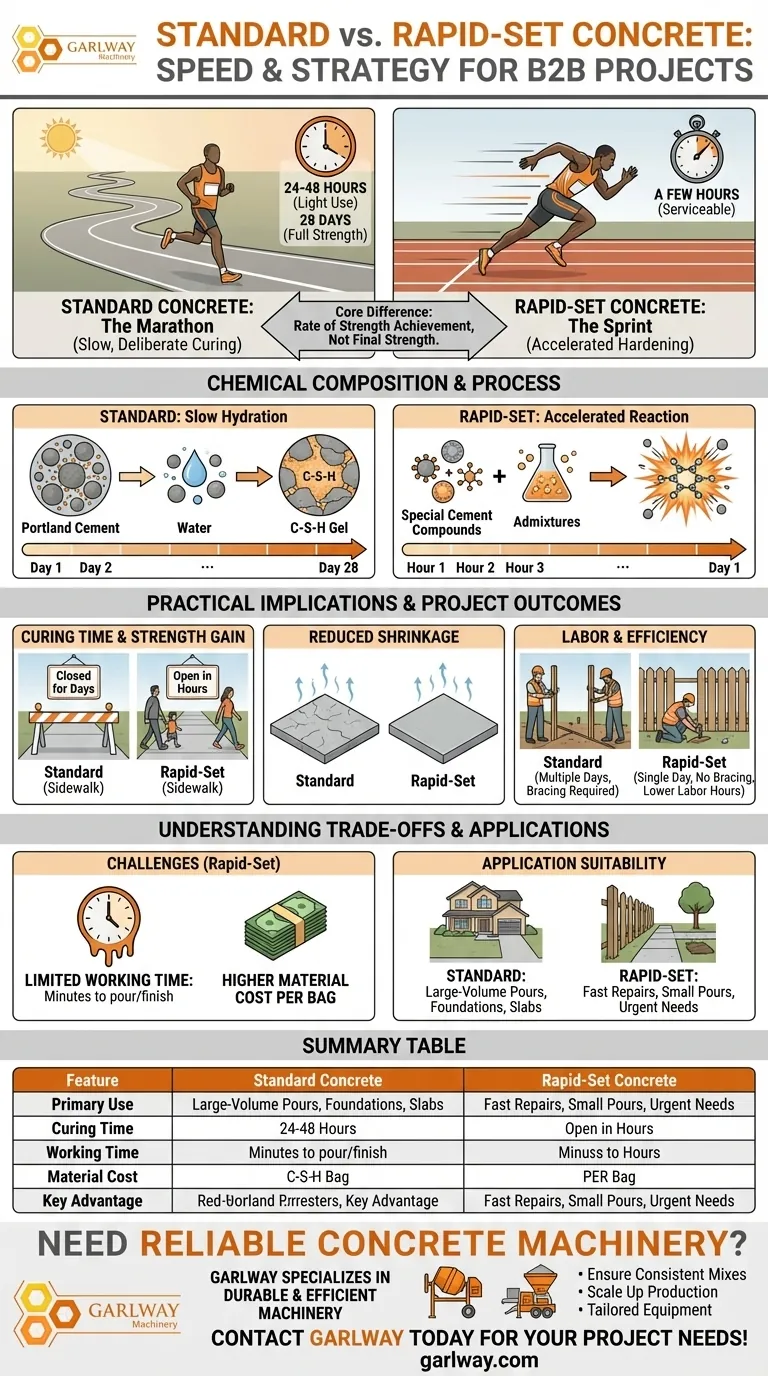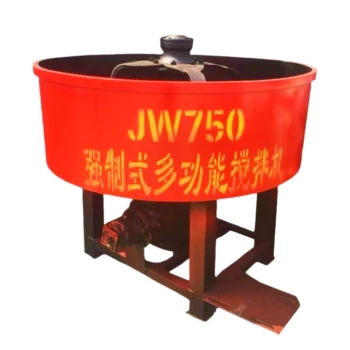In essence, rapid-set concrete is engineered for speed. It achieves its strength and hardens significantly faster than standard concrete mixes, a process that can take a few hours rather than several days. This accelerated curing time offers unique benefits, including reduced shrinkage and the potential to lower overall labor and project costs.
The fundamental difference isn't the final strength but the rate at which that strength is achieved. Standard concrete is a marathon, curing slowly and deliberately, while rapid-set is a sprint, designed for projects where time is the most critical factor.

The Core Difference: Chemical Composition
The distinct behaviors of standard and rapid-set concrete stem from their chemical makeup and the resulting hydration process.
Standard Concrete: The Deliberate Process
Standard concrete relies on the slow, methodical hydration of Portland cement. This process requires a significant amount of time—often 24 to 48 hours—before the concrete can handle light foot traffic, and up to 28 days to reach its full specified strength.
Rapid-Set Concrete: The Accelerated Reaction
Rapid-set concrete includes special cement compounds and chemical admixtures. These additives dramatically accelerate the hydration reaction, forcing the concrete to gain strength and set in a fraction of the time. This allows it to be put into service much more quickly.
Practical Implications for Your Project
Understanding the chemical difference is key, but the practical outcomes are what truly matter when choosing a material.
Curing Time and Strength Gain
This is the most significant differentiator. A project using standard concrete, like a sidewalk repair, might need to be cordoned off for a couple of days. The same repair with rapid-set concrete could be open to traffic in just a few hours.
Reduced Shrinkage
As standard concrete cures slowly, water evaporates over a longer period, which can lead to shrinkage and potential cracking. Rapid-set concrete's quick chemical reaction consumes water faster, which can help mitigate this type of shrinkage.
Labor and Project Efficiency
The speed of rapid-set concrete directly translates to cost savings on certain jobs. For projects like setting fence posts or anchoring railings, it eliminates the need for temporary bracing and allows you to complete the work in a single day, reducing total labor hours.
Understanding the Trade-offs
While speed is a major advantage, it comes with important considerations that make it unsuitable for certain applications.
Limited Working Time
The primary drawback of rapid-set concrete is its extremely short working time. Once water is added, you have only a few minutes to mix, pour, and finish the surface. This can be very challenging for inexperienced users or for large, complex pours.
Higher Material Cost
The specialized chemical admixtures make rapid-set concrete more expensive per bag than standard mixes. While it can lower total project costs through labor savings, the initial material outlay is higher.
Application Suitability
Standard concrete is the go-to for large-volume pours like foundations, driveways, and large slabs where ample working time is essential. Rapid-set excels in repairs, small pours, and applications where minimizing downtime is the top priority.
Making the Right Choice for Your Goal
Select your concrete based on the specific demands of the task at hand.
- If your primary focus is a new, large-scale project without a tight deadline (like a foundation or large patio): Standard concrete offers the most working time and is the most cost-effective material choice.
- If your primary focus is a fast repair or a project requiring quick use (like setting fence posts or repairing a walkway): Rapid-set concrete is the superior option, as its speed minimizes downtime and labor costs.
Choosing the right concrete is about aligning the material's properties with your project's most critical resource: time.
Summary Table:
| Feature | Standard Concrete | Rapid-Set Concrete |
|---|---|---|
| Primary Use | Large-scale projects (foundations, slabs) | Fast repairs, small pours (fence posts, walkways) |
| Curing Time | 24-48 hours for light use; 28 days for full strength | A few hours to be put into service |
| Working Time | Ample time for mixing, pouring, and finishing | Very limited (only a few minutes) |
| Material Cost | Lower per bag | Higher per bag |
| Key Advantage | Cost-effective for large volumes; more working time | Minimizes project downtime and labor costs |
Need Reliable Concrete Machinery for Your Project?
Whether you're planning a large-scale pour with standard concrete or a rapid repair job, having the right equipment is crucial for success. GARLWAY specializes in providing durable and efficient construction machinery, including concrete mixers and batching plants, for construction companies and contractors globally.
Let us help you optimize your concrete work:
- Ensure consistent mixes with our reliable concrete mixers.
- Scale up your production with our efficient batching plants.
- Get the right equipment tailored to your project's needs, whether for standard or rapid-set applications.
Contact GARLWAY today to discuss your machinery requirements and keep your projects on schedule!
Visual Guide

Related Products
- Belle Cement Mixer JS2000 Volumetric Concrete Mixer for Harbor Freight
- Harbor Freight JS1500 On Site Concrete Mixing Volumetric Cement Mixer
- Ready Mixer Machine for Construction Ready Mix Machinery
- JZC500 Large Cement Mixer Machine Price for Concrete Mix
- HZS75 Concrete Batching Plant Cement Mixer Price Concrete Mixer Bunnings Mixing Plant
People Also Ask
- What are the advantages of a volumetric concrete mixer? Achieve Total Control & Zero Waste
- What are some innovations in volumetric concrete mixers? Boost Efficiency with On-Demand Production
- What type of concrete mixer is volumetric? Gain On-Site Control & Eliminate Waste
- What are the main advantages of volumetric concrete mixers? Achieve On-Demand Concrete & Cost Control
- What is the purpose of a volumetric concrete mixer? Gain On-Demand Mixing & Zero Waste



















